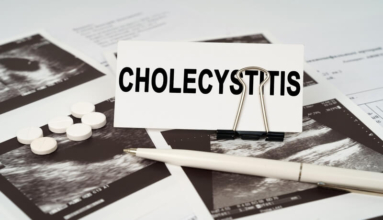Abdominal Aortic Aneurysm
- Abdominal aortic aneurysm usually grow gradually and can burst.
- They might create a throbbing feeling in the abdomen and, if ruptured, lead to intense pain, low blood pressure, and potentially fatal outcomes.
- Physicians frequently discover aneurysms incidentally during tests for other conditions.
- Treatment includes blood pressure-lowering drugs, and large or expanding aneurysms are treated with surgery or a stent insertion procedure.
Abdominal aortic aneurysms grow slowly but can burst, causing a throbbing abdomen and intense pain. Rupture leads to a drop in blood pressure and can be fatal. Doctors often find these aneurysms during exams or imaging for other reasons. Treatment includes blood pressure medications. Large or growing aneurysms need surgery or a stent.
The aorta, the largest artery, distributes oxygen-rich blood from the heart. Its abdominal section is prone to aneurysms. Men aged 50 to 80, especially smokers, are at higher risk. Hereditary factors and conditions like high blood pressure also increase risk. About 20% of these aneurysms rupture.
Smoking greatly increases this risk, particularly in men. Atherosclerosis commonly causes these aneurysms. Infections or inflammation in the aorta can also weaken the artery wall.
Symptoms of Abdominal Aortic Aneyrysms
People with an abdominal aortic aneurysm often don’t have symptoms, but some might feel a throbbing in their abdomen. The aneurysm can cause deep, sharp back pain due to pressure on the spine or nearby areas. This pain can be strong and constant, worsening if the aneurysm leaks.
If the aneurysm ruptures, intense lower abdomen and back pain usually occur first, with tenderness above the aneurysm. Extensive internal bleeding can quickly lead to shock. A ruptured aneurysm is often life-threatening and always needs immediate treatment to prevent being fatal.
Diagnosis of Abdominal Aortic Aneurysms
Ultrasonography or computed tomography (CT) scans of the abdomen play a crucial role in diagnosing abdominal aortic aneurysms. Pain might indicate an aneurysm, but it often doesn’t appear until the aneurysm is quite large or close to rupturing. Doctors frequently find aneurysms incidentally during routine physical exams or imaging tests like X-rays, CT, or ultrasound performed for other reasons.
During an exam, doctors may detect a pulsating mass in the center of the abdomen and hear a whooshing noise (bruit) with a stethoscope, suggesting blood turbulence near the aneurysm. However, detecting aneurysms in individuals with obesity can be challenging, even if the aneurysm is large. Rapidly growing aneurysms that are nearing rupture often cause pain or tenderness during an abdominal examination.
Sometimes, an abdominal X-ray shows an aneurysm with calcium deposits in its wall, but this method is less effective for detecting aneurysms or determining their size. Ultrasonography usually effectively reveals the size of an aneurysm. When doctors find an aneurysm, they might use ultrasonography periodically to monitor its growth.
CT Scans
CT scans of the abdomen, particularly with an intravenously injected contrast agent, provide more precise information about an aneurysm’s size and shape than ultrasonography, but they involve radiation exposure. Magnetic resonance imaging (MRI) is also accurate in assessing aneurysms but might not be as available as ultrasonography or CT.
Doctors sometimes recommend screening for abdominal aortic aneurysms using ultrasonography in asymptomatic individuals over 65 years old, especially in men who have smoked or have a family history of such aneurysms.
Treatment of Abdominal Aortic Aneyrysms
Sometimes, doctors replace aneurysms with a synthetic graft. Smaller abdominal aortic aneurysms, under 2 inches (5 cm), are less likely to rupture. Treatments for these include blood pressure medications, statins, aspirin, and quitting smoking.
Doctors use regular imaging to track aneurysm growth and decide on surgery. They might start with tests every 3 to 6 months, adjusting as the aneurysm grows.
Larger aneurysms, over 2 to 2½ inches (5 to 5.5 cm), have a higher rupture risk. Doctors often suggest repair for these, unless it’s too risky. In Marfan syndrome cases, they might recommend earlier repair, even for smaller aneurysms near the heart.
Repairing an aneurysm involves placing a synthetic graft in the weakened aorta.
There are two main methods for this surgery.
- Traditional Surgery: This approach involves administering general anesthesia followed by a surgical incision extending from below the breastbone to just below the navel. The graft is sewn into the aorta, and the aneurysm’s walls are then wrapped around this graft before closing the incision. The surgery typically lasts between 3 to 6 hours, with a hospital stay ranging from 5 to 8 days. The risk of death during this type of surgery is approximately 2 to 5%, although this risk can increase in the presence of other serious health conditions.
- Endovascular Stent Graft Repair: This is the second approach (4.5 cm) in diameter.
Various factors, such as a person’s age, overall health, and the specific structure of their aorta and aneurysm, guide the choice of technique for aneurysm repair. Surgeons typically prefer open surgery for younger, healthier individuals because of its more durable outcomes, especially in patients expected to live at least another 10 years. However, they often choose endovascular stent grafting for older individuals or those in poorer health, who may not tolerate the strain of open surgery well.
When an abdominal aortic aneurysm ruptures or is about to rupture, immediate emergency intervention becomes necessary. This can involve either open surgery or the placement of an endovascular stent graft. The mortality risk for emergency repair of a ruptured aneurysm is about 50%. However, this risk might reduce to around 20 to 30% with endovascular stent graft placement.
A rupture can critically affect the kidneys, disrupting their blood supply or as a result of shock from significant blood loss. Kidney failure onset after repairing a ruptured aneurysm significantly lowers survival chances.


